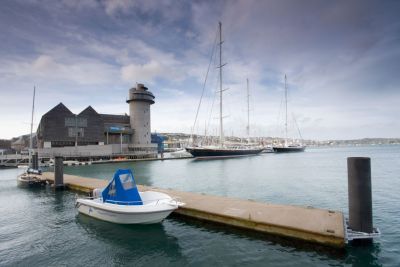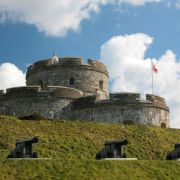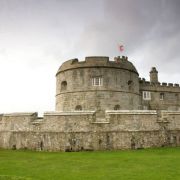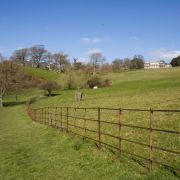
The National Maritime Museum is well placed in an ideal position overlooking Falmouth harbour and the busy Carrick Roads shipping area. The maritime heritage exhibition is presented on three floors in twelve impressive galleries, each of which focuses on a different aspect of industry, work or communications. There are various audio, visual and interactive displays throughout the award winning building.
The Bartlett Library contains a wide and interesting collection of maritime reference books, periodicals and other archive material. It is fully available for public reference and admission to the resource is free. This library contains information on the construction and usage of many types of boat and information on the maritime heritage of Cornwall. The collection of over thirteen thousand volumes falls broadly into three categories: the Small Boat section relates particularly to the museum's own boats; the Maritime Reference section includes publications, such as Lloyd’s Registers of Shipping and Mercantile Navy Lists, a wide range of books covering subjects from fishing boats to aircraft carriers, and a small selection of books on naval subjects; periodicals and journals, covering various aspects of maritime enterprise. There are several databases on local aspects of maritime history, such as the Falmouth Packet Service.
The Look Out the top of the tower offers great views over the harbour and estuary and, in addition to the binoculars and telescopes, there are interactive facilities offering information about the sights, including historic buildings, coastal features and landmarks, and vessels in harbour. North across the water is the village of Flushing, former home of Packet Ship captains, whilst inland to the west is the Custom House Quay where the customs used to bring back contraband goods seized from ships.
The Nav Station is a gallery with various interactive exhibits explaining navigation and meteorology. It demonstrates how sea charts are made and used. A real time link with the Met Office gives up to date international weather information, the local conditions given from the data collecting weather station on top of the tower.
Set Sail is an audio-visual experience offering the stories of nine different. This includes film footage and interviews with well known sailors and designers, bringing each story to life. The boats include a canoe used to break the world altitude canoeing record and a life raft which drifted for over a hundred days in the ocean.
Start Line demonstrates the various uses of boats in work, leisure and sport. This includes some of the most amazing exploits such as the single handed crossing of the Atlantic in a kayak. This gallery shows the diverse uses of different small vessels from different cultures and shows how boats are some of the earliest aids known to humans – long before such things as the wheel.
The new Flotilla 2006 exhibition is all about endurance and survival. It tells the stories of such adventurers as Ernest Shackleton, Ellen MacArthur and Robin Knox-Johnston. This gallery displays the mental and physical challenges of the expeditions undertaken by such people.
The Tidal Zone allows the visitor to look out into the harbour through two large underwater windows. It is possible to see such sights as a cormorant diving through the water in search of a fish. The exhibition also includes explanations of the tides and how they are affected by the phases of the moon. There is also an interactive introduction to many of the animals and plants living in the estuary.
At the Waterfront is a large boating pool with a difference, where fans blow the wind across the water. The members of staff who work here demonstrate how to sail into, or away from the wind using radio-controlled boats. Visitors can try their hand at this and it proves a great attraction for all ages
Cornish people have always had strong connections with the sea, so the Cornwall and the Sea exhibition explains how Cornish people have made a living from the sea and how local craft were built. There are tales of the lives of Cornish fishermen, explanations of the traditional way in which sails were made and even the reconstruction of a pilchard cellar. One of the prize exhibits here is the Robertson Packet Ship Gallery, which celebrates Falmouth’s role in the development of global communications from the 18th century onwards.
The Museum is open daily throughout the year, except Christmas Day and Boxing Day. It is fully accessible to wheelchair users, with lift and ramp access to all floors, including the Tower. There is parking
just across the cobbled Museum Square, with designated parking spaces.
In addition to all the wonderful galleries, there is a fine lecture theatre available for hire by companies and other organisations. The café serves drinks and snacks and offers great views over the harbour, and a shop sells souvenirs, postcards and local craft work.





